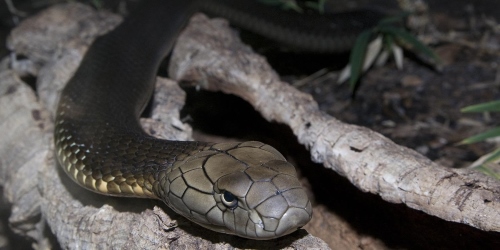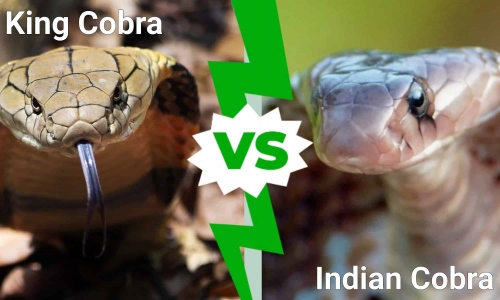Snakes have been fascinating creatures in nature throughout time. Among the most iconic venomous snakes are the King Cobra (Ophiophagus hannah) and the Indian Cobra (Naja naja). While both species are known for their hooded appearance and deadly venom, they have distinct differences in size, venom potency, behaviour, and habitat. This article provides an in-depth comparison between these two powerful serpents.
Differences Between King Cobra and Indian Cobra
1. Scientific Classification
| Feature | King Cobra | Indian Cobra |
| Scientific Name | Ophiophagus hannah | Naja naja |
| Genus | Ophiophagus (not a true cobra) | Naja (true cobra) |
| Family | Elapidae | Elapidae |
2. Size and Physical Characteristics
The King Cobra is the longest venomous snake in the world, often reaching lengths of 19 feet. The Indian Cobra, though significantly smaller, is still a large and highly venomous snake.
| Feature | King Cobra | Indian Cobra |
| Length | 10-19 ft (largest venomous snake) | 4-7 ft (can reach up to 10 ft in rare cases) |
| Weight | 10-15 lbs | 2.5-6 lbs |
| Hood Markings | No spectacle-shaped markings, chevron patterns on neck | Distinct spectacle-shaped markings on hood |
3. Venom Strength and Lethality

Source:nationalzoo
- King Cobra Venom: While the King Cobra can inject a large quantity of venom, it is less potent than that of the Indian Cobra. Its venom is neurotoxic, affecting the nervous system and causing respiratory failure.

Source:inaturalist
- Indian Cobra Venom: The Indian Cobra’s venom is far more potent and highly neurotoxic, making it responsible for thousands of deaths annually. It is part of India’s “Big Four” snakes, known for causing the most human fatalities.
| Feature | King Cobra | Indian Cobra |
| Venom Quantity per Bite | Up to 1000 mg | 170-250 mg |
| The LD50 is the amount of a substance that kills 50% of a test population exposed to it. | 1.28 mg/kg (less potent) | 0.56 mg/kg (more potent) |
| Annual Human Fatalities | Rarely kills humans | Responsible for ~15,000 deaths annually |
4. Fangs and Bite Mechanism
Both snakes have fixed fangs, meaning they do not retract like vipers. However, the King Cobra’s fangs are longer, allowing it to inject a massive dose of venom in a single bite.
| Feature | King Cobra | Indian Cobra |
| Fang Length | 0.5 inches | 0.3 inches |
| Bite Mechanism | Bites and holds onto prey | Bites and chews to inject venom |
5. Habitat and Distribution
The King Cobra has a wider range and adapts to various environments, while the Indian Cobra is more commonly found near human settlements, increasing human-snake encounters.
| Feature | King Cobra | Indian Cobra |
| Geographical Range | Indian subcontinent, Southeast Asia | Indian subcontinent |
| Preferred Habitat | Forests, grasslands, swamps | Agricultural fields, human settlements, forests |
6. Behavior and Aggression
The King Cobra is less aggressive towards humans and primarily preys on other snakes, including cobras. The Indian Cobra, on the other hand, is more territorial and defensive, making it a greater threat to humans.
| Feature | King Cobra | Indian Cobra |
| Temperament | Generally non-aggressive, avoids humans | Skittish and more likely to bite when provoked |
| Diet | Primarily eats other snakes (including cobras) | Feeds on small mammals, birds, and amphibians |
7. Cultural Significance
The Indian Cobra holds a sacred place in Indian culture. It is often depicted in Hindu mythology, particularly with Lord Shiva, who is shown with a cobra around his neck. The King Cobra, while respected for its size, does not have the same cultural reverence.
| Feature | King Cobra | Indian Cobra |
| Symbolism | Feared and respected for size and strength | Revered in Indian culture and mythology |
| Religious Importance | Associated with fear and power | Worshiped in Hindu mythology, linked to Lord Shiva |
Who Would Win in a Fight?

Source:a-z-animals
In a direct battle between a King Cobra and an Indian Cobra, the King Cobra would likely win due to the following factors:
- Size Advantage: The King Cobra is nearly three times longer and significantly heavier.
- Venom Quantity: It injects more venom in a single bite.
- Predatory Behaviour: The King Cobra naturally preys on other snakes, including cobras.
- Fang Size: Larger fangs allow deeper venom injection.
Although the Indian Cobra’s venom is more potent, it would struggle against the King Cobra’s strength and venom delivery system. However, such battles are rare in nature, as both species prefer to avoid confrontation.
Which cobra is more dangerous to humans?
The Indian Cobra is the deadlier snake in terms of human risk. Its venom is more potent, and since it is commonly found in agricultural areas and urban settlements, snakebites are frequent. The King Cobra, on the other hand, is more reclusive and rarely interacts with humans.
| Feature | King Cobra | Indian Cobra |
| Human Fatality Risk | Low | High (~15,000 deaths annually) |
| Encounters with Humans | Rare | Frequent |
| Venom Effect on Humans | Lethal in large doses, but rarely used on humans | Extremely lethal even in small doses |
Conclusion
Both the King Cobra and the Indian Cobra are formidable snakes, each with its own unique strengths:
- The King Cobra is the longest venomous snake, feared for its size and ability to prey on other snakes.
- The Indian Cobra is smaller but far deadlier to humans, as its venom is highly potent and responsible for thousands of deaths each year.
While the King Cobra would likely win in a head-to-head fight, the Indian Cobra remains the greater threat to human life due to its frequent encounters and lethal venom.
Understanding these differences helps in appreciating these remarkable creatures while ensuring proper safety measures are taken to avoid dangerous encounters.
Comments
All Comments (0)
Join the conversation